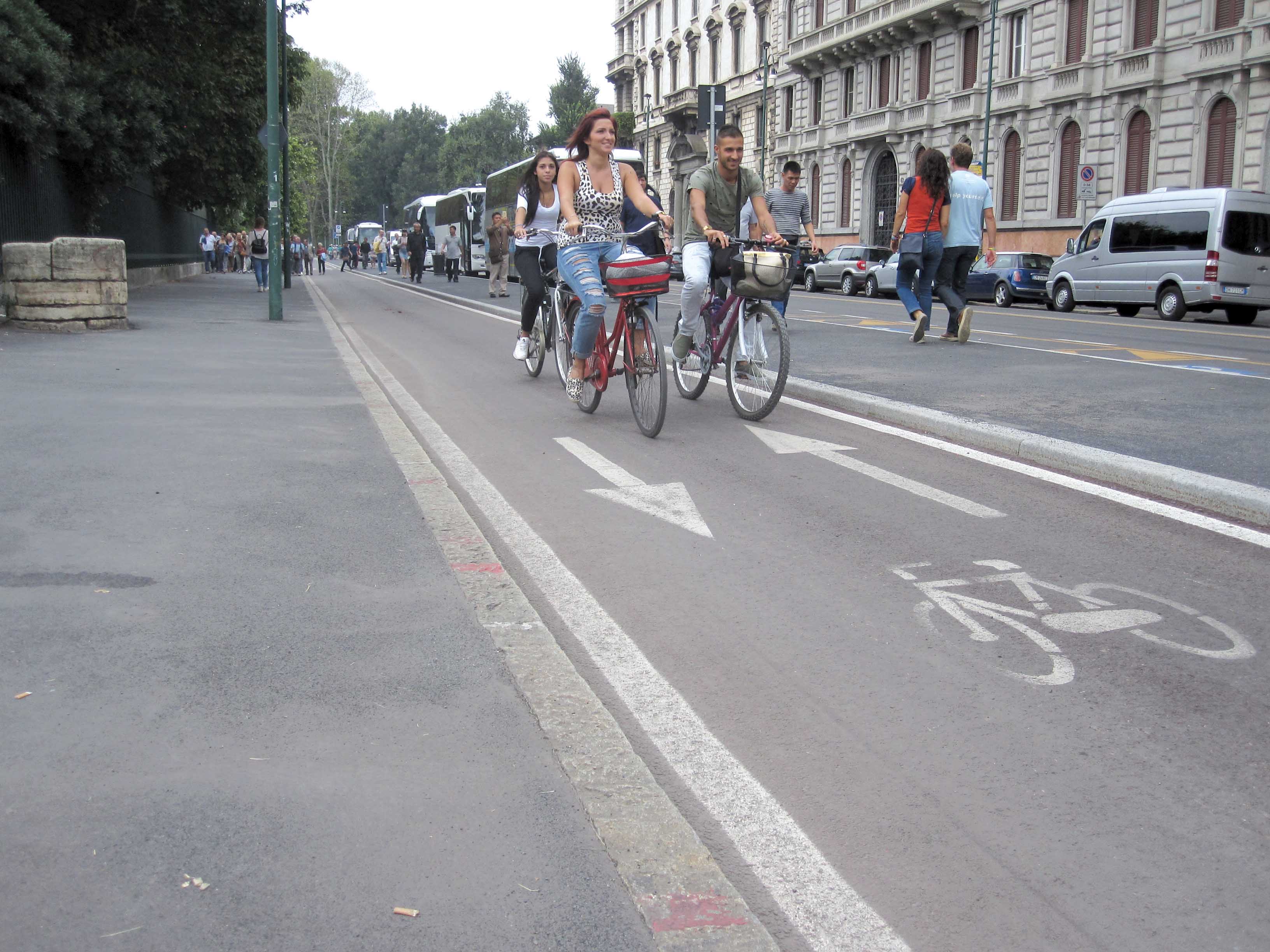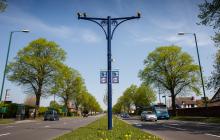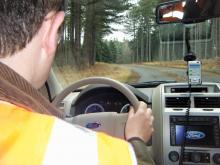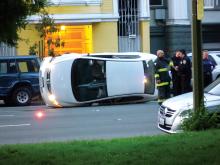The state of Europe’s road surfaces “is absolutely vital” if TISPOL, the European Traffic Police Network, is going to achieve its target of halving road deaths across the continent by 2020 says AA president Edmund King
Speaking at the 2015 TISPOL annual conference in Manchester, King warned that the deteriorating state of Europe’s road pavements has become “a serious problem” and that the number of potholes is now an important road safety issue for the enforcement community.

Not enough road routes have separate cycles lanes
The state of Europe’s road surfaces “is absolutely vital” if TISPOL, the European Traffic Police Network, is going to achieve its target of halving road deaths across the continent by 2020 says 3440 AA president Edmund King
Speaking at the 20154753 TISPOL annual conference in Manchester, King warned that the deteriorating state of Europe’s road pavements has become “a serious problem” and that the number of potholes is now an important road safety issue for the enforcement community.
King spoke about a British soldier who recently returned from a tour of duty in Afghanistan only to die on the UK roads when he swerved to avoid a pothole. He survived the Taliban, but he did not survive the deadly state of Europe’s road surfaces, King said. And the problem is getting worse, particularly for the non-strategic highway network. Road maintenance funds allocated to local government are not ring-fenced properly, King told the conference, and the money often gets diverted elsewhere. Cuts in local government budgets will continue to make the situation worse.
The situation “is regrettable” King said, and there is no easy solution in sight. He was sharing the keynote opening platform with Szabolcs Schmidt, head of the road safety unit at the European Commission’s directorate general for mobility and transport, who argued that Europe’s key transnational highway corridors and major domestic strategic highway systems are all in good shape and that the EU should move toward the user pays principle to fund infrastructure investment at a more local level.
Quite right, King agreed, Europe’s motorway systems and major national highways are fine, it is everything else that is falling apart … and the user pays idea is pointless. general public are not going to accept it. In countries like the UK, King pointed out, road users are already contributing £44 billion a year to the government coffers, but only see £8 billion reinvested in the road network. A recent survey showed that “87% of the British public simply don’t trust the UK government.” They don’t believe that government will re-invest the money it takes from drivers into the road system, King said. It is a broken model and many local roads across Europe are rotting as a result.
We need a political solution and new levels of commitment to improving the state of Europe’s local roads, the conference was told, but “there needs to be that trust, and it isn’t there.” Many UK politicians also see the road user pays problem as “a poll tax on wheels” King told World Highways. “Right now, it’s just not a vote-winning idea.”
TISPOL was using the Manchester conference to call for the better protection of vulnerable road users. Traffic police across the EU are going to focus hard on ridding Europe’s roads of dangerous drivers. “Road safety targets are good,” the group agreed in an official statement. “They unite all those groups working to reduce death and injury on Europe’s roads. We want to see political will restored across Europe, and a commitment from governments to avoid any further cuts to policing resources to allow police officers to enforce existing laws, investigate collisions effectively, and identify and sanction the most dangerous drivers.”
For TISPOL President Aidan Reid, the “traffic police have a vital role to play in reducing deaths and serious injuries on the roads of Europe. Central to this is the task of identifying and sanctioning those drivers who pose unacceptably high risks. They may be disqualified, uninsured, or simply have a flagrant disregard for the rules of the road which are there to help keep everyone safe. Robust systems are in place to deal with high-end offenders, but there needs to be effective enforcement and consistent, tough sentencing in order to provide a worthwhile deterrent.”
Conference topics included safer driving in later life; fatigue in emergency service drivers; police strategies to reduce motorcycle casualties; safer cycle commuter journeys and women drivers, alcohol and increased vulnerability.
When it came to motorbike and bicycle casualties, TISPOL looked a recent AA Populuspoll of 17,629 drivers in the UK. The results were clear: “Failure to look properly is the most commonly cited (44%) contributory factor in UK road crashes. 109 cyclists and 331 motorbike riders died in 2013 (this increased to 113 cyclists and 339 riders in 2014)” despite the fact that “motorcyclists make up just 1% of traffic.” However, motorbikes make up “19% of all fatalities. They are 55 times more likely than car drivers to be killed or seriously hurt in an accident.”
Why? Because “nine out of ten drivers (93%) admit it is sometimes hard to see cyclists while driving” said the survey. “85% say it is hard to see motorcyclists and more than half (55%) are often ‘surprised when a cyclist appears from nowhere’.”
The fight is far from won. The conference was disappointed to report that a steady 15-year-long fall in the number of road fatalities, injuries and accidents across the 28 member states of the EU since 2000 has suddenly started to flatten out, and without any obvious explanation.
One possible cause could be the increasing age of Europe’s demographic profile. Are there too many drivers who are just too old to be on the road, Sergeant Rob Heard of Hampshire Police asked? If the average driver’s reaction times, eyesight, spatial awareness and hearing are all impaired by age, is there a case for targeting this part of the road user community more effectively? Heard talked the conference through an “Older drivers’ forum” project that he has been working on. The scheme sets up an “awareness week” and sets out to “visit six different venues” during that time. More than “100 older drivers attended on each day,” Heard said. “We gave advice on brushing up their driving skills; booking a voluntary driving assessment; having a free eyesight test and arranging regular eyesight tests; getting advice on health and well-being issues that could affect their driving ability; advice on renewing their licences at 70; learning more about road safety and the consequences of not being fit to drive; and discovering alternatives to driving and staying independent without a car.”
The organisers homed in on the sort of problems and vulnerabilities that come with old age. For instance, Heard said, “for drivers with a notifiable medical condition or disability that affects their driving” the forum recommends the use of a local mobility centre that has been “accredited by the DVLA to undertake medical ‘Fitness to Drive’ assessments. It uses specialist driving advisors such as occupational therapists and approved driving instructors for doing the assessments.” There is a “pre-drive physical, cognitive and visual screening process, followed by an on-road assessment using a range of standard and adapted vehicles.” The centres will also give advice on mobility and driving aids.”
Fatigue came up several times during the two-day event in Manchester. Yvonne Taylor from North Yorkshire Police took an interesting look at how it affects the driving habits of shift workers as part of a PhD she is doing with the Institute for Transport Studies at the University of Leeds. She cited a raft of recent research papers on the matter pointing out that “there are more than 3.5 million shift workers in the UK; that sleepiness peaks are generally around 03.00 to 05.00 and 14.00 to 16.00 when increases in fatigue-related road traffic collisions take place; that shift-work-induced fatigue is a significant risk factor increasing the likelihood of accident and injury; that fatigue accounts for up to 20% of serious collisions on motorways and monotonous roads in Great Britain and that police shift work is associated with a high prevalence of sleep disorders and self-reported drowsy driving.”
She has surveyed a group of colleagues, all of who worked on a rotating shift pattern, and concluded that there is no such thing as a morning or an evening person … everyone is vulnerable to a lack of regular sleep. Taylor’s initial findings show that “in the 12 months preceding the study, 5.8% (of the participants) stated that they had been involved in a collision or road departure on the way to or from work; that 51.9% stated that they had been involved in a ‘near miss’ such as a kerb strike, lane departure or near-collision; that 95.7% of these incidents happened on the way home from work and that 61.8% had been working a nightshift prior to the incident.”
Other papers looked at fatality rates across the 28 EU states. Eastern Europe remains the worst region with the UK, Spain, Scandinavia and the Netherlands leading the way.
Since the new century began, it is only the passenger car sector that is reducing its share of the overall EU fatality stats. Cyclists, motorcyclists and the elderly are all continuing to see their share of the figures worsen.
Caroline Moore, a senior analyst with EuroRAP, the EU-wide road assessment programme that monitors the quality of the continent’s road surfaces, also pointed out that the road user is not always to blame. Badly and ineptly designed roads are often a major factor, along with poor maintenance standards. EuroRAP continues to independently monitor the EU road network, pointing out areas for improvement. There is still plenty of work to be done.
Speaking at the 2015
King spoke about a British soldier who recently returned from a tour of duty in Afghanistan only to die on the UK roads when he swerved to avoid a pothole. He survived the Taliban, but he did not survive the deadly state of Europe’s road surfaces, King said. And the problem is getting worse, particularly for the non-strategic highway network. Road maintenance funds allocated to local government are not ring-fenced properly, King told the conference, and the money often gets diverted elsewhere. Cuts in local government budgets will continue to make the situation worse.
The situation “is regrettable” King said, and there is no easy solution in sight. He was sharing the keynote opening platform with Szabolcs Schmidt, head of the road safety unit at the European Commission’s directorate general for mobility and transport, who argued that Europe’s key transnational highway corridors and major domestic strategic highway systems are all in good shape and that the EU should move toward the user pays principle to fund infrastructure investment at a more local level.
Quite right, King agreed, Europe’s motorway systems and major national highways are fine, it is everything else that is falling apart … and the user pays idea is pointless. general public are not going to accept it. In countries like the UK, King pointed out, road users are already contributing £44 billion a year to the government coffers, but only see £8 billion reinvested in the road network. A recent survey showed that “87% of the British public simply don’t trust the UK government.” They don’t believe that government will re-invest the money it takes from drivers into the road system, King said. It is a broken model and many local roads across Europe are rotting as a result.
We need a political solution and new levels of commitment to improving the state of Europe’s local roads, the conference was told, but “there needs to be that trust, and it isn’t there.” Many UK politicians also see the road user pays problem as “a poll tax on wheels” King told World Highways. “Right now, it’s just not a vote-winning idea.”
TISPOL was using the Manchester conference to call for the better protection of vulnerable road users. Traffic police across the EU are going to focus hard on ridding Europe’s roads of dangerous drivers. “Road safety targets are good,” the group agreed in an official statement. “They unite all those groups working to reduce death and injury on Europe’s roads. We want to see political will restored across Europe, and a commitment from governments to avoid any further cuts to policing resources to allow police officers to enforce existing laws, investigate collisions effectively, and identify and sanction the most dangerous drivers.”
For TISPOL President Aidan Reid, the “traffic police have a vital role to play in reducing deaths and serious injuries on the roads of Europe. Central to this is the task of identifying and sanctioning those drivers who pose unacceptably high risks. They may be disqualified, uninsured, or simply have a flagrant disregard for the rules of the road which are there to help keep everyone safe. Robust systems are in place to deal with high-end offenders, but there needs to be effective enforcement and consistent, tough sentencing in order to provide a worthwhile deterrent.”
Conference topics included safer driving in later life; fatigue in emergency service drivers; police strategies to reduce motorcycle casualties; safer cycle commuter journeys and women drivers, alcohol and increased vulnerability.
When it came to motorbike and bicycle casualties, TISPOL looked a recent AA Populuspoll of 17,629 drivers in the UK. The results were clear: “Failure to look properly is the most commonly cited (44%) contributory factor in UK road crashes. 109 cyclists and 331 motorbike riders died in 2013 (this increased to 113 cyclists and 339 riders in 2014)” despite the fact that “motorcyclists make up just 1% of traffic.” However, motorbikes make up “19% of all fatalities. They are 55 times more likely than car drivers to be killed or seriously hurt in an accident.”
Why? Because “nine out of ten drivers (93%) admit it is sometimes hard to see cyclists while driving” said the survey. “85% say it is hard to see motorcyclists and more than half (55%) are often ‘surprised when a cyclist appears from nowhere’.”
The fight is far from won. The conference was disappointed to report that a steady 15-year-long fall in the number of road fatalities, injuries and accidents across the 28 member states of the EU since 2000 has suddenly started to flatten out, and without any obvious explanation.
One possible cause could be the increasing age of Europe’s demographic profile. Are there too many drivers who are just too old to be on the road, Sergeant Rob Heard of Hampshire Police asked? If the average driver’s reaction times, eyesight, spatial awareness and hearing are all impaired by age, is there a case for targeting this part of the road user community more effectively? Heard talked the conference through an “Older drivers’ forum” project that he has been working on. The scheme sets up an “awareness week” and sets out to “visit six different venues” during that time. More than “100 older drivers attended on each day,” Heard said. “We gave advice on brushing up their driving skills; booking a voluntary driving assessment; having a free eyesight test and arranging regular eyesight tests; getting advice on health and well-being issues that could affect their driving ability; advice on renewing their licences at 70; learning more about road safety and the consequences of not being fit to drive; and discovering alternatives to driving and staying independent without a car.”
The organisers homed in on the sort of problems and vulnerabilities that come with old age. For instance, Heard said, “for drivers with a notifiable medical condition or disability that affects their driving” the forum recommends the use of a local mobility centre that has been “accredited by the DVLA to undertake medical ‘Fitness to Drive’ assessments. It uses specialist driving advisors such as occupational therapists and approved driving instructors for doing the assessments.” There is a “pre-drive physical, cognitive and visual screening process, followed by an on-road assessment using a range of standard and adapted vehicles.” The centres will also give advice on mobility and driving aids.”
Fatigue came up several times during the two-day event in Manchester. Yvonne Taylor from North Yorkshire Police took an interesting look at how it affects the driving habits of shift workers as part of a PhD she is doing with the Institute for Transport Studies at the University of Leeds. She cited a raft of recent research papers on the matter pointing out that “there are more than 3.5 million shift workers in the UK; that sleepiness peaks are generally around 03.00 to 05.00 and 14.00 to 16.00 when increases in fatigue-related road traffic collisions take place; that shift-work-induced fatigue is a significant risk factor increasing the likelihood of accident and injury; that fatigue accounts for up to 20% of serious collisions on motorways and monotonous roads in Great Britain and that police shift work is associated with a high prevalence of sleep disorders and self-reported drowsy driving.”
She has surveyed a group of colleagues, all of who worked on a rotating shift pattern, and concluded that there is no such thing as a morning or an evening person … everyone is vulnerable to a lack of regular sleep. Taylor’s initial findings show that “in the 12 months preceding the study, 5.8% (of the participants) stated that they had been involved in a collision or road departure on the way to or from work; that 51.9% stated that they had been involved in a ‘near miss’ such as a kerb strike, lane departure or near-collision; that 95.7% of these incidents happened on the way home from work and that 61.8% had been working a nightshift prior to the incident.”
Other papers looked at fatality rates across the 28 EU states. Eastern Europe remains the worst region with the UK, Spain, Scandinavia and the Netherlands leading the way.
Since the new century began, it is only the passenger car sector that is reducing its share of the overall EU fatality stats. Cyclists, motorcyclists and the elderly are all continuing to see their share of the figures worsen.
Caroline Moore, a senior analyst with EuroRAP, the EU-wide road assessment programme that monitors the quality of the continent’s road surfaces, also pointed out that the road user is not always to blame. Badly and ineptly designed roads are often a major factor, along with poor maintenance standards. EuroRAP continues to independently monitor the EU road network, pointing out areas for improvement. There is still plenty of work to be done.








